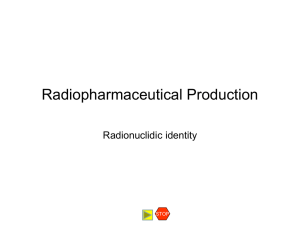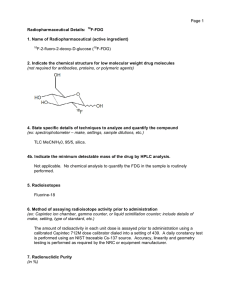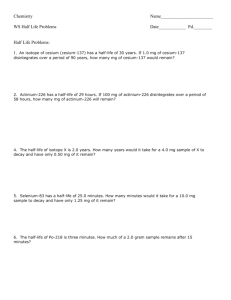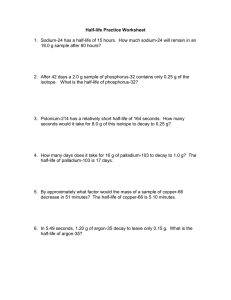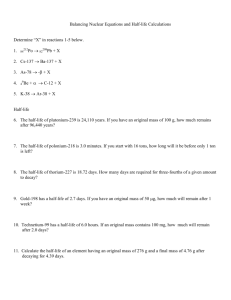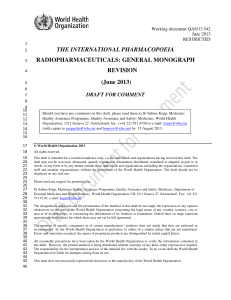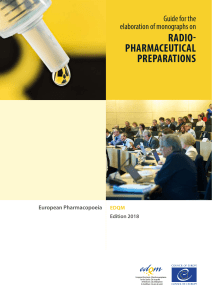Radionuclidic identity and purity
advertisement
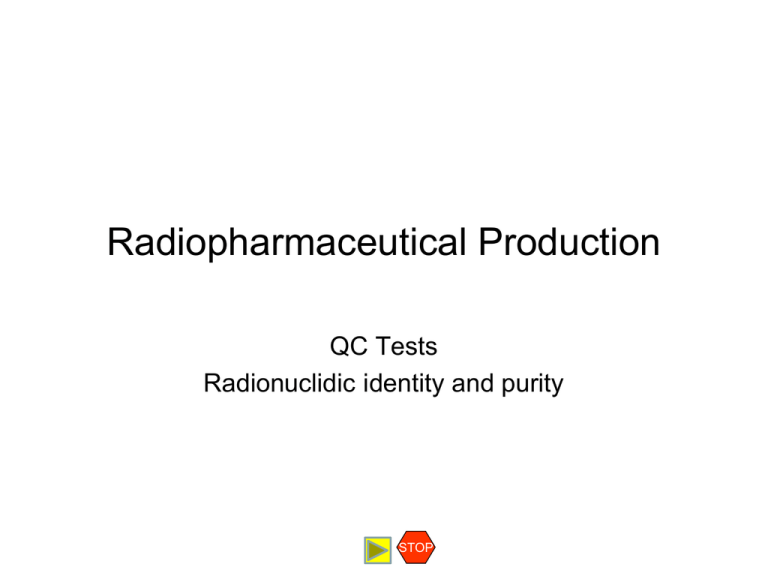
Radiopharmaceutical Production QC Tests Radionuclidic identity and purity STOP Radionuclidic identity and purity • • • Radiochemical purity is defined as the fraction of total radioactivity that is present in the desired product. It is important that the radiolabel is in the specified molecular position. If the radiolabel is in any other position in the molecule or in any other chemical form it is regarded as radiochemical impurity. Radiochemical impurities may originate during the manufacturing process because of incomplete reactions, side reactions, or incomplete removal of protective groups in the precursor molecule or radiolysis. Contents • Acceptance Criteria • Discussion • Procedure STOP Acceptance Criteria Radiopharmaceutical Production QC Tests Radionuclidic Identity and Purity Contents Acceptance Criteria Discussion Procedure STOP Acceptance Criteria: The measured physical half-life of the test sample should be between 105 and 115 minutes. The test should be completed on every batch prior to release of the product. The gamma spectrum of the test sample should show the major peak at 511 KeV, and a sum peak at 1022 KeV depending on geometry and detector efficiency. Not less than 99% of the gamma emissions should correspond to 18F. Normally the gamma spectrum test is performed periodically and not on every batch. Discussion Radiopharmaceutical Production QC Tests Radionuclidic Identity and Purity Contents Acceptance Criteria Discussion Procedure STOP Discussion: Half-life: Half life can be determined within the acceptable limits using counting equipment, such as dose calibrator or a well counter by measuring radioactivity of the test sample at two or more time points, and then calculating the halflife from the decay. As a practical matter (considering the short half-life of 18F and the need to release the product as soon as possible), a precisely measured counting time of 10 minutes is generally sufficient to determine the physical half-life . The measured half life will be lower if an impurity such as 13N is present in FDG. During validation studies, it is common to count over a longer time and/or at more frequent time points to improve the assurance of radionuclidic purity. Discussion: Gamma Spectrum: It must be realized that the mere presence of 511 KeV or 1022 KeV peak in γ-ray spectrum is not sufficient to determine radionuclidic identity. Impurities such as 13N (arising from 16O impurity in the target) or other positron emitters will not be detected. Therefore, a combination of the gamma spectrum and the half-life measurement provide the best assurance of radionuclidic identity and purity. Procedure Radiopharmaceutical Production QC Tests Radionuclidic Identity and Purity Contents Acceptance Criteria Discussion Procedure Procedure: For half-life measurement, place a small aliquot of the test sample in a dose calibrator or in a well counter (see the link to an example procedure for this test using the pH strip). Record the initial radioactivity (A0). Record the radioactivity again after at least 10 minutes (A10). The times should be recorded to the nearest second to avoid potential errors in the time that can lead to inaccurate determination of the half-life. Link to example procedure Calculate the half-life from the two measured values as per the formula: T1/2 = 0.693 x t / [2.03 x [Log A0-Log A10]: where T1/2 and t are in minutes. Procedure: For the Gamma spectrum test: Record the gamma spectrum (NaI or HPGe) of a test sample that has been diluted appropriately (and quantitatively) to provide optimum number of counts. STOP Return to Main Menu
